Habibi (Pantheon, $35.00)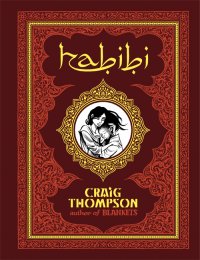
By D. S. Randlett
Craig Thompson is an important creator in the field of comics. Where most of the field seems content with chasing down the cool or the weird, Thompson seeks to evoke subtler and deeper emotions. He is a great artist, his pages always have a definite sense of motion to them, and his characters are great actors. However, I do think that he has a lot of room to grow as a writer, as I typically feel a sense of disconnect from his work despite the ambition and skill he brings to everything that he does. So, I suppose that I must preface this review by saying that even though I have my reservations about this book, it is very much a must read.
One question that often comes up around comics: Is it a writer’s medium, or an artist’s medium? This may seem like an odd question to ask, as a comic book is manifestly both words and pictures, both something written and something rendered. There remains a lot of conflict over who the real storytellers in the medium are, and whether comics should skew more to the written or the drawn. There are some hardliners on either side out there, but it ultimately comes down to what will benefit the story.
Habibi is the story of a young girl and a young man, Dodola and Cham, who form a bond as children, are separated, and then meet once again as lovers. There is much that happens between those lines, of course. If I had to point my finger to what the story is essentially about, it would the isolation of the individual from their own sexuality by their culture. The story breaks off into other thematic jaunts, too. Sex as oppression, sex as liberation, mysticism, the power of stories and storytelling. Habibi is a book with a lot on its mind.
But maybe a little bit too much for the story to really satisfy. Looking back on my reading of this book, I can’t think of an instance where I really felt connected to the characters or their story. Reading Habibi was, for me, a rather academic experience. It is a work rich in symbolism and meaning, but it triggers a tickling of the intellect rather than an engaging of the heart, but it does not feel as if this were the intent. Thompson’s art is brilliant, but I think he the book would have benefited from better prose. The art is very deft at showing the events of the story, and the reactions that they inspire in the characters, but the internal journeys of Dodola and Cham (particularly Cham) are for the most part invisible to the reader. In the end, it is a book that registers halfway, evoking only a part of what it is intending.
Still, Habibi is not without its rewards. As I’ve mentioned before, the art is just gorgeous. And even though its attempts to inspire the heart end up tickling the intellect instead, it is nonetheless a pleasant sensation. On the whole, Habibi really is quite good, but its disappointments and frustrations make it hard to embrace with a full heart.
Rating: 




Out of a Possible 5 Stars
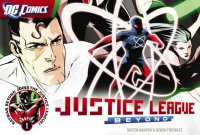 Justice League Beyond #1 & 2 (DC Comics, $0.99 – Digital Comic via Comixology)
Justice League Beyond #1 & 2 (DC Comics, $0.99 – Digital Comic via Comixology)
by Graig Kent
As much as I enjoyed Paul Dini and Bruce Timm’s Batman: The Animated Series (and really who didn’t, that show remains golden), I never could much get into their original concept, Batman Beyond. Perhaps it was the purist or loyalist in me, but unless it originated in the comics I wasn’t all that interested (I wasn’t much a fan of Black Vulcan, Apache Chief, the Wonder Twins and any other original creation on Super Friends either). Also, I wasn’t very enamored with the future-Deco look of the series, and the pained attempts at deriving a futuristic youth rave scene (oh, those loopy club sequences) dated themselves almost immediately. But with the rather intense Batman Beyond film Return of the Joker heavily tied to old continuity, I started to see the appeal of the Beyond universe in its origins, filling in the gaps between “today” and the future. When it cropped up in the Justice League animated series with the Beyond League, well I got downright excited by it, with its sense of legacy as well as progression. While I still haven’t warmed up to Terry McGinnis completely, I have developed at least a curious interest in the world/universe/time he inhabits.
DC has been gently experimenting with the digital marketplace, quietly releasing a few titles on a digital-only platform with collections to come further down the road. These include the recent spinoff series from the Arkham City video game and Beyond the Fringe, based on the Fox TV series. Last month, they also debuted both a Batman Beyond comic and a Justice League Beyond comic digitally, which they’re compiling together for the Batman Beyond Unlimited monthly anthology.
The digital versions are noticeably only 11-pages in length (cut in half and billed as 22-pages) and coming out twice-monthly, so essentially full length issues split into two for the same price. It’s 99 cents each, which is pretty much equal to the usual $1.99 of a digital comic, and the $3.99 price tag of the Batman Beyond Unlimited print edition lines up as well, so there’s no real gain or loss by going one way or the other. That is unless, like me, you only want to read one or the other.
To be straight, the first two digital issues of Justice League Beyond comprise really only the first issue overall of the story, so there’s not really a sense of compressing more of the story into 11 pages. Written and illustrated by Dustin Nguyen, co-written and inked by Derek Fridolfs, the story opens with the Jokerz gang squaring off against the Animal Kingdom, a gang of man-beast hybrids. It naturally draws the attention of the Beyond League and it’s a three-way melee. It wraps up soon enough and the League is called back to HQ to be debriefed by Superman (Beyond) regarding their teammate Micron (the future’s Atom). Superman suspects that he’s gone native while undercover infiltrating the still-a-going-concern Kobra terrorist cult.
It’s an extremely pedestrian story that feels like a typical DC Animation-to-comics project, stripped of any teeth and muted down for an all-ages audience. When I was barely 10 I was reading Wolfman & Perez’s Teen Titans which was wall-to-wall with action and dialogue, with multiple characters getting a moment or two to shine each issue, whether it was Cyborg’s coming to terms with his condition, Kid Flash’s romantic feelings for an emotionally distant Raven, the threat from Starfire’s past, or infiltrating the creepy though not-explicitly-Satanic cult of Brother Blood. Comparatively, here we have a drab confrontation between rival gangs, and the set-up for a longer story. The point being, nothing happens. We’re not introduced to the characters at all, and there’s little sense of personality adopted by any of them. They’re coasting on visible recognition, and treading thin on the memories of them from their Justice League animated appearance.
Nguyen cops an effective on-model style for the DC Animated universe, but doesn’t really bring much more to it. From recent works on Batman: Streets of Gotham (with Paul Dini, no less) and Batgirl, I’ve seen him work in numerous different styles, and use them creatively within the same story. His figure work has always suffered from inconsistency, but he’s been known to do his storytelling a little outside the box which has made him fun to read in the past. There’s no hints of that here. The overly simplified future-deco world might have been a necessity in the cartoon, but artists have the chance to design future Gotham beyond that (if you’ll pardon the pun) and Nguyen and Fridolfs don’t attempt to. It’s not altogether terrible a comic, it’s just deathlessly uninteresting.
Rating: 




Out of a Possible 5 Stars
The Vault (Image, $9.99)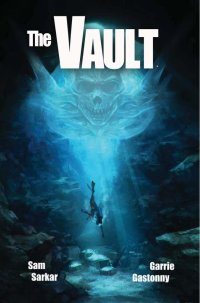
By Jeb D.
(Sneak Peek review: release date is 3/7/12)
When reading the biographical material at the end of this book, I wasn’t terribly surprised to learn that writer Sam Sarkar works with Johnny Depp’s production company, and that the property has been optioned for feature film adaptation: The Vault is textbook big-screen monster movie material, blending elements of The Abyss, The Thing, and Alien(s).
The plot’s pretty straightforward: a team of high-tech treasure hunters, most with secret agendas, are excavating a mysterious site, and find both less, and more, than they bargained for. Obviously, in such a familiar story, the details matter, and Sarkar does a decent job of providing a convincing technical environment for the team’s efforts. The characterization is a bit less effective, as an awful lot of the cast seem to be playing stock roles (do the names Jesus, Michael, and Gabrielle ring any bells?), and anytime something more or less “mysterious” happens, enormous fingers of suspicion are blatantly pointed. There’s also one “romantic” moment tossed in from so far out of left field as to be almost laughable. But, then, this sort of thing is lingua franca in the movies that provide the book’s inspiration, and some readers would probably feel that Sarkar was playing them false if he didn’t include them; you’ll know every story beat before it happens, but sometimes that’s part of the fun.
Artist Garrie Gastonny (Supergod) proves a good director/cinematographer/editor for Sarkar’s tale, bringing the creepy as required, with nicely consistent character work. The action scenes are good, with the underwater sections particularly claustrophobic. He’s somewhat hampered, though, by Sarkar’s structure: when you don’t have to pay an expensive FX team to create your monster, there’s no value in spending three-fourths of your story on talky, predictable buildup, particularly since Gastonny has realized a very effective creature design. There’s also the problem of the spectacular three-page supernatural battle that opens the story: by the time you near the end of this book, it’s pretty clear that we’re only at the beginning of the tale being told, and that said battle is at least another volume or two in the future, thus reducing the stakes for the immediate story.
All in all, fans of Gastonny will want to take a peek, as he’s in fine form, but anyone else might consider saving their money for the film.
Rating: 




Out of a Possible 5 Stars
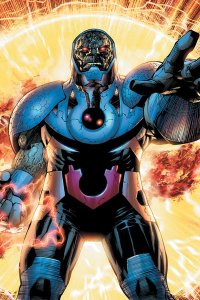 Justice League #6 (DC, $3.99)
Justice League #6 (DC, $3.99)
By D.S. Randlett
Justice League was the flagship book of the New 52 relaunch, and in a lot of ways this first arc encapsulates everything about the New 52, both good and bad. As to the good, this roster of characters felt fresh again, like a friend with a new haircut. There was a sense of fun present in this arc that’s been missing from a company that could get very bogged down in self-serious Crisis-related stuff. In the face of that, having Superman talk a little smack to Batman was a bit of a welcome change of pace. But then there’s the bad. JL is a shallow fight comic, which is part of its appeal, but it manages to rob some of the magic of something like “the first time Superman met Batman” by having this be the first time that all of these heroes have ever met. A lot of character dynamics get lost in the shuffle, and things start moving way to fast, and eventually characters start making sacrifices that make no sense.
But worst of all is the treatment of Darkseid here. When Darkseid shows up, it should feel like a huge deal. If I’m a new reader, the kind of reader that DC purportedly wants to attract, this Darkseid character means nothing to me, except for the fact that he seems able to give the Justice League a run for their money. There’s not a lot of “who” when it comes to our villains, and this robs the story of a lot of the stakes it might have had. There’s lots of big stuff happening, but it’s almost context.
In turn, the resolution has very little impact. The good guys win, as expected, but the world’s rejoicing and acceptance of these heroes ends up having little impact. What we’ve been seeing for the past six issues is, more or less, precisely what we expect. Which wouldn’t be so bad, but this first arc has been geared more towards dropping hints in the face of big action moments rather than the character interaction that drives really great team books.
Johns and Lee do drop some rather enticing hints, but they’re enough to make this first arc seem like something less than setup for bigger and better things. These first few months of Justice League, like much of these first few months of the New 52, have felt like treading water until we’re ready to actually start swimming.
Rating: 




Out of a Possible 5 Stars
The Situation (tor.com free)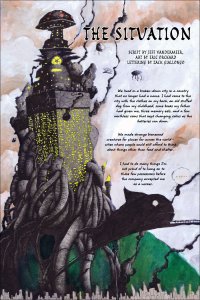
by Graig Kent
Much criticism typically results from adapting a novel or prose story into a movie, of how much has to be cut out or edited or changed as a result of the shift in format. Too often (almost always) when a film is made from a prose story, the film doesn’t capture entirely the feel of the book. Naturally so, since they are two completely different media after all. The impact upon the consumer, the senses and parts of the brain it’s stimulating are going to be different. You don’t hear as much complaining, relatively speaking, when books get adapted into comics. Perhaps it’s because they have more in common, sharing the printed page as it were. The act of reading a comic and of reading a book aren’t altogether that different. But it’s this kinship of sharing type and words that I feel makes comic adaptations of prose even more at risk of failure than film adaptations. For all the straying, I find that cinematic translations of books tend to stay truer to their format than comic book translations. Where cinema will often abandon whole sections of story, perhaps even a key narrative voice in order to service the structure of cinematic storytelling, comics trend towards trying to retain too much of the book, too much of the prose. Perhaps the comic adaptation is more faithful to the original source by carrying over more of the story’s words to its pages, but they don’t always remain faithful to the nature of comic book storytelling.
The Situation was a short story written by Jeff Vandermeer and first published in Wired in 2008, and is now presented, in its entirety, as a comic book on tor.com (for free), adapted by the author and illustrated by Eric Orchard. In translating his own story, Vandermeer falls into the same trap so many prose-to-comic adaptations do… it remains too wordy, relying too much upon the narration, rather than the illustrations, to advance the story. As a result, Eric Orchard’s beautiful ink and watercolor illustrations are exactly that, illustrations accompanying the story, and not so much sequential art that makes the comic book medium so unique. In other words, it’s a picture book.
But it’s a lovely picture book.
Vandermeer’s story is a delightfully weird one, a corporate fable of sorts, taking ideas from the common office work experience and trapping them in a fantastical land where technology is organic, where information is alive, and gadgets can be pets, parasites or anything in between. The main character, Wick, is a developer, working on the Fish Rots From Head project, and finding it to be a more frustrating experience with each passing day. His coworkers are hostile, his manager is far too delicate, and the HR department just won’t leave him alone. In a cryptic way, this is the story of routine office life, but the eccentricities put it more in the Naked Lunch camp rather than Office Space. It’s not intentionally funny, but it is humorous in the fleshing out of its world (quite literally speaking). It’s as frequently puzzling as it is entertaining, but in that respect it invites repeated readings for greater clarity.
As I noted, Eric Orchard’s illustrations are, simply put, gorgeous. Like a modern-day Edward Gorey with all the goth removed, Orchard draws in loose frameworks filled with dense lines within a highly developed use of white space. I’m familiar with Orchard’s black-and-white work (having stumbled into some self-published mini-comics at the Toronto Fan Expo a few years back) and it continues to impress me immeasurably. Here his watercolors are equally masterful as his line work, adding to the already impressive textures he’s created with his inks. While it’s not a true comic book effort, it’s still exemplary illustration work. When he finally unleashes a true graphic novel, the comic world will definitely stand up and take notice (not that they shouldn’t already).
The Situation is a different reading experience, and not just because it’s on-line. It’s rewarding in its own right, although frustrating at times for its adoption of a medium but not any conviction to it format. It’s definitely worth a look, and equally worth the time.
Rating: 




Out of a Possible 5 Stars